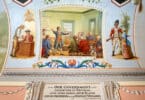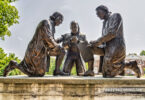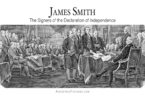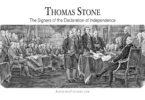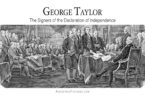George Walton was born in approximately 1749 in Cumberland County, Virginia. The exact year of his birth is not known, and some biographers have guessed it to be as early as 1740 or as late as 1750. Yet, 1749 seems to be the most commonly accepted birth year for him. Della Gray Bartholomew, the official biographer of the signers of the Declaration of Independence, used the birthdate of 1741 for George.
George was orphaned as an infant, losing both of his parents around the same time. After that, he was adopted by an uncle. As a child, George entered into an apprenticeship as a carpenter with this uncle. The issue was that George loved to study, and his uncle was against it, believing studiousness to only be an excuse to be idle. George studied on his own, on the side, and then moved to Savannah, Georgia, after his apprenticeship ended in 1769. In Savannah, George studied law under Mr. Young and was admitted to the bar in 1774 as an attorney.
By the time the American Revolution came around, George was one of the most successful lawyers in Georgia. George took up the cause of the patriots, and this support of the cause led to his being elected Secretary of the Georgia Provincial Congress and the president of the Council of Safety. George was appointed as a delegate from Georgia to the Continental Congress in Philadelphia in 1776 and kept this position until late 1778. George voted in favor of the Declaration of Independence on July 2, 1776, along with fellow Georgia delegates Lyman Hall and Button Gwinnett.
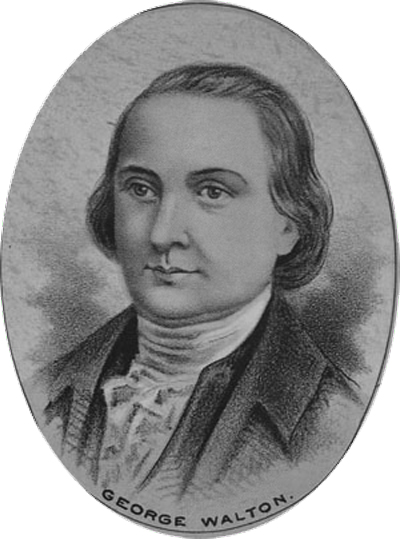
During the American Revolution, George was in the militia, serving in the battalion of General Robert Howe. This was the position he went into immediately after serving in the Second Continental Congress. On January 9, 1778, George was given a commission as a colonel of the First Georgia Regiment of Militia. George was injured during the Battle of Savannah by being hit in the thigh by a musket ball thrown from his horse and taken prisoner by the British. The British allowed the wound to heal before sending him to Sunbury Prison, which was being used to keep other American prisoners at the time. In October of 1779, George was released in a prisoner exchange.
While George was being kept as a prisoner of war, his brother, John Walton, signed the Articles of Confederation for Georgia along with Edward Telfair and Edward Langworthy.
Almost immediately upon being released by the British, George was elected Governor of Georgia, though he was only Governor for two months. This was because George was a political ally of Lachlan McIntosh, who was a political foe of Button Gwinnett, George’s fellow Declaration signer. This made George and Button political enemies, and their quarrels led to George being expelled from the office of governor and indicted for various crimes. None of the indictments involved a conviction, though he was censured for his support of the duel between Lachlan and Button, in which Button was killed.
George did not stay down for long, though. He was elected to the US Senate as a representative from Georgia. In this role, he helped to mediate a land dispute between South Carolina and Georgia, which helped better define the borders between the two states. George was appointed to the Constitutional Convention in 1787, but he declined this appointment, as he had commitments to Georgia state politics at that time that left little time for anything else. George served as a presidential elector from Georgia in 1789 and also served on the Georgia state convention to ratify the nation’s new Constitution.
Also, in 1789, George was elected to a second term as Governor of Georgia. During this second term, which was one year in duration, Georgia adopted the new Constitution as well as a new state constitution, moved the state capital to Augusta (where George had moved shortly before becoming Governor for the second time), and concentrated on settling the western frontier of the state. After leaving the office of governor, George served as a judge on the state’s superior court in 1790 and for the rest of his life. George also filled in the unexpired term of James Jackson in the US Senate from Georgia in 1795 and 1796. George was, additionally, a founder and trustee of the Academy of Richmond County in Augusta and of Franklin College (now known as the University of Georgia) in Athens.
While serving his second tenure as Governor of Georgia, George built a house he called Meadow Garden. The house, which was called a cottage, was built on land confiscated from British Loyalists after the American Revolution. The land was located just outside of Augusta, Georgia. It was there that George crossed to the other side in 1804, in his mid-fifties, if approximations of his birth date are correct. George left behind his wife, Dorothy Camber, whom he wed in 1775, and one son (George and Dorothy had two sons, but only one lived past George).
George was initially buried at a place called Rosney, which was the name of the house of his nephew, Robert Watkins. Later, in 1848, George was moved and re-buried underneath the Signers Monument, located in front of the courthouse on Greene Street in Augusta, Georgia.
Walton County, Georgia, is named after George. Several schools in Georgia are also named after him. George’s surviving son, George Walton, Jr, was the first Secretary of the Territory of Florida and also the first civilian to serve as Governor of the territory, a role which he temporarily filled as Acting Governor until the intended Governor, William Duval, arrived. Walton County, Florida, is named after George Walton, Jr. So, father and son each have counties in neighboring states named after them.
Though George was from Virginia and later spent most of his adult life in Georgia, which was both a slave colony (and later, a state), George was, in fact, one of the few signers of the Declaration of Independence who did not, at some point, own slaves.

